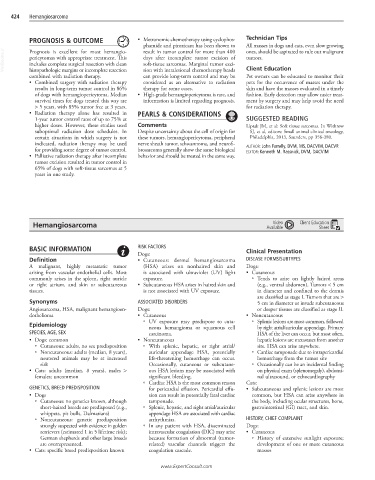Page 876 - Cote clinical veterinary advisor dogs and cats 4th
P. 876
424 Hemangiosarcoma
PROGNOSIS & OUTCOME • Metronomic chemotherapy using cyclophos- Technician Tips
phamide and piroxicam has been shown to All masses in dogs and cats, even slow growing
VetBooks.ir pericytomas with appropriate treatment. This days after incomplete tumor excision of tumors.
ones, should be aspirated to rule out malignant
result in tumor control for more than 400
Prognosis is excellent for most hemangio-
soft-tissue sarcomas. Marginal tumor exci-
includes complete surgical resection with clean
Client Education
histopathologic margins or incomplete resection
combined with radiation therapy. sion with intralesional chemotherapy beads Pet owners can be educated to monitor their
can provide long-term control and may be
• Combined surgery with radiation therapy considered as an alternative to radiation pets for the occurrence of masses under the
results in long-term tumor control in 86% therapy for some cases. skin and have the masses evaluated in a timely
of dogs with hemangiopericytoma. Median • High-grade hemangiopericytoma is rare, and fashion. Early detection may allow easier treat-
survival times for dogs treated this way are information is limited regarding prognosis. ment by surgery and may help avoid the need
> 5 years, with 85% tumor free at 3 years. for radiation therapy.
• Radiation therapy alone has resulted in PEARLS & CONSIDERATIONS
1-year tumor control rates of up to 75% at SUGGESTED READING
higher doses. However, these studies used Comments Liptak JM, et al: Soft tissue sarcomas. In Withrow
suboptimal radiation dose schedules. In Despite uncertainty about the cell of origin for SJ, et al, editors: Small animal clinical oncology,
certain situations in which surgery is not these tumors, hemangiopericytoma, peripheral Philadelphia, 2013, Saunders, pp 356-380.
indicated, radiation therapy may be used nerve sheath tumor, schwannoma, and neurofi- AUTHOR: John Farrelly, DVM, MS, DACVIM, DACVR
for providing some degree of tumor control. brosarcoma generally show the same biological EDITOR: Kenneth M. Rassnick, DVM, DACVIM
• Palliative radiation therapy after incomplete behavior and should be treated in the same way.
tumor excision resulted in tumor control in
65% of dogs with soft-tissue sarcomas at 5
years in one study.
Video
Hemangiosarcoma Available Client Education
Sheet
BASIC INFORMATION RISK FACTORS Clinical Presentation
Dogs:
Definition • Cutaneous: dermal hemangiosarcoma DISEASE FORMS/SUBTYPES
A malignant, highly metastatic tumor (HSA) arises on nonhaired skin and Dogs:
arising from vascular endothelial cells. Most is associated with ultraviolet (UV) light • Cutaneous
commonly arises in the spleen, right auricle exposure. ○ Tends to arise on lightly haired areas
or right atrium, and skin or subcutaneous • Subcutaneous HSA arises in haired skin and (e.g., ventral abdomen). Tumors < 5 cm
tissues. is not associated with UV exposure. in diameter and confined to the dermis
are classified as stage I. Tumors that are >
Synonyms ASSOCIATED DISORDERS 5 cm in diameter or invade subcutaneous
Angiosarcoma, HSA, malignant hemangioen- Dogs: or deeper tissues are classified as stage II.
dothelioma • Cutaneous • Noncutaneous
○ UV exposure may predispose to cuta- ○ Splenic lesions are most common, followed
Epidemiology neous hemangioma or squamous cell by right atrial/auricular appendage. Primary
SPECIES, AGE, SEX carcinoma. HSA of the liver can occur, but most often,
• Dogs: common • Noncutaneous hepatic lesions are metastases from another
○ Cutaneous: adults, no sex predisposition ○ With splenic, hepatic, or right atrial/ site. HSA can arise anywhere.
○ Noncutaneous: adults (median, 8 years), auricular appendage HSA, potentially ○ Cardiac tamponade due to intrapericardial
neutered animals may be at increased life-threatening hemorrhage can occur. hemorrhage from the tumor site
risk Occasionally, cutaneous or subcutane- ○ Occasionally can be an incidental finding
• Cats: adults (median, 8 years), males > ous HSA lesions may be associated with on physical exam (splenomegaly), abdomi-
females; uncommon significant bleeding. nal ultrasound, or echocardiography
○ Cardiac HSA is the most common reason Cats:
GENETICS, BREED PREDISPOSITION for pericardial effusion. Pericardial effu- • Subcutaneous and splenic lesions are most
• Dogs sion can result in potentially fatal cardiac common, but HSA can arise anywhere in
○ Cutaneous: no genetics known, although tamponade. the body, including ocular structures, bone,
short-haired breeds are predisposed (e.g., ○ Splenic, hepatic, and right atrial/auricular gastrointestinal (GI) tract, and skin.
whippets, pit bulls, Dalmatians) appendage HSA are associated with cardiac
○ Noncutaneous: genetic predisposition arrhythmias. HISTORY, CHIEF COMPLAINT
strongly suspected with evidence in golden ○ In any patient with HSA, disseminated Dogs:
retrievers (estimated 1 in 5 lifetime risk); intravascular coagulation (DIC) may arise • Cutaneous
German shepherds and other large breeds because formation of abnormal (tumor- ○ History of extensive sunlight exposure;
are overrepresented. related) vascular channels triggers the development of one or more cutaneous
• Cats: specific breed predisposition known coagulation cascade. masses
www.ExpertConsult.com

